
From the California Natural Resources Agency:
In an effort to improve habitat and flows in the Delta and key tributaries, the California Department of Water Resources and the Department of Fish and Wildlife today submitted documents to the State Water Resources Control Board outlining potential voluntary agreements to support environmental objectives through a broad set of tools, while protecting water supply reliability.
The documents, available on the Natural Resources Agency website, reflect progress since December to flesh-out the previously submitted framework to improve conditions for fish through targeted river flows and a suite of habitat-enhancing projects including floodplain inundation and physical improvement of spawning and rearing areas. Further work and analysis is needed to determine whether the agreements can meet environmental objectives required by law and identified in the State Water Board’s update to the Bay-Delta Water Quality Control Plan.
“Today’s submittal is an important step forward towards protecting the environment and providing greater long-term certainty to water users, “Governor Gavin Newsom said. “I appreciate that so many diverse parties, north and south, from the environmental community and water users alike, continue to work collaboratively towards voluntary agreements. Much hard work remains, but I am encouraged by the continued progress.”
The State Water Board is in the process of updating its Bay-Delta Plan, which establishes water quality measures that provide reasonable protection of beneficial uses in the greater Bay-Delta watershed. At its December 12 meeting, the board adopted an updated plan for the Lower San Joaquin River and three tributaries. It also directed its technical staff to work with the Natural Resources Agency to consider voluntary agreements across Delta watersheds as an alternative for consideration by State Water Board members.
A cover letter signed by 44 individuals representing water users, conservation groups, and state and federal agencies accompanied today’s submittal. The letter expressed commitment to further analysis and work to reach voluntary agreements that can serve as an alternative path to implementing the Bay-Delta Plan’s objectives. While agreement does not exist among all of the parties for the project described in today’s proposal, the letter outlined a common commitment “to try to reach a Voluntary Agreement that advances California on the path toward sustainable water management.”
“Voluntary agreements hold the promise of meeting environmental objectives in ways that also protect water supply reliability for cities, farms and businesses,” California Secretary for Natural Resources Wade Crowfoot said. “I’m encouraged with this progress, but more work is needed. We will work with the State Water Board staff to assess this proposal and develop agreements that can meet multiple objectives.”
The package submitted today is the product of renewed discussions over the past six weeks since Governor Gavin Newsom took office. It includes a project description identifying resources and actions that could be deployed to support environmental and biological objectives and a planning agreement that outlines an implementation approach and terms for the additional work ahead.
“While there is much more work to be done, the package submitted today represents a great deal of collaboration toward managing habitat, flow and other factors needed to protect and enhance native fish and wildlife species,” Department of Fish and Wildlife Director Charlton H. Bonham said.
The voluntary agreements would integrate habitat improvements with functional, managed flows across seven watersheds to achieve the Bay-Delta Plan’s objectives. The proposal outlines a 15-year program that involves habitat improvements, including creation of spawning and rearing habitat for salmon and smelt, completion of high-priority fish screen projects, restoration and reactivation of flood plains, projects to address predation, and fish passage improvements. Other measures include pulse flows, reservoir reoperation, land fallowing, groundwater banking and reduced diversions.
These assets would be accompanied by blocks of additional new water for managed flows, local water agency funding for water acquisition, and more than $260 million to fund additional science and restoration activities. The proposal also includes a comprehensive science program as well as a structured decision-making process to guide implementation to achieve outcomes.
“Science tells us a broad set of tools is required to manage habitat and flow while protecting water supply reliability,” Department of Water Resources Director Karla Nemeth said. “Large-scale environmental restoration across watersheds is challenging, but we’re making progress because of collaboration. That’s good for water users north and south, and natural river systems from the Sierra to the sea.”
Participants in the voluntary agreements discussions will continue to develop terms for agreements and inform the analysis of the proposal for legal and scientific adequacy.
Voluntary agreements discussions involve the Natural Resources Agency, Department of Water Resources, Department of Fish and Wildlife, technical staff from the State Water Board, the U.S. Bureau of Reclamation, water managers from the Sacramento, Yuba, Feather, Mokelumne, American, and Tuolumne river watersheds, south-of-Delta exporters, members of the Friant Water Authority, Delta water agencies and environmental conservation groups. This diverse group has committed to continue working together in an effort to resolve one of California’s most vexing environmental issues.

